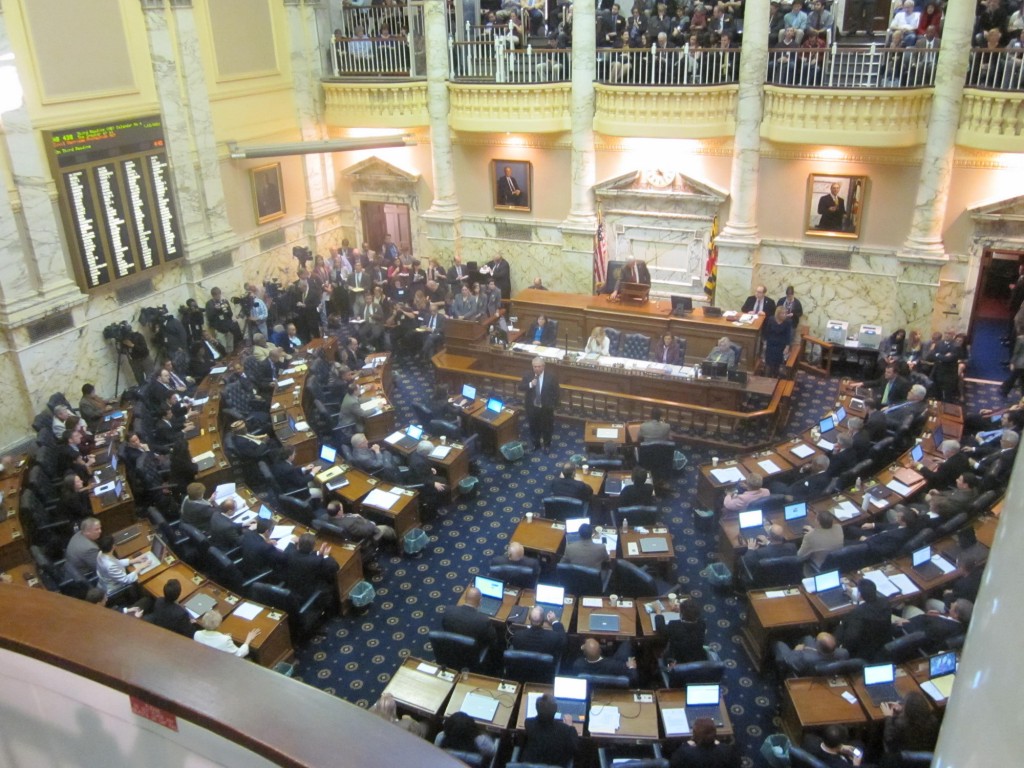 Maryland House of Delegates
Maryland House of Delegates
The Legislature:
•Enacts laws necessary for the welfare of the State’s citizens and certain laws dealing with counties and special taxing districts.
•Proposes amendments to the Maryland Constitution, which must be ratified by the voters during the general election.
•Reviews the Governor’s Reapportionment and Redistricting plans.
•Meets in regular session for 90 calendar days each year beginning the second Wednesday in January to act on more than 2500 pieces of legislation and the State’s annual capital and operating budgets.
•Meets in special session when called by the Governor or when a majority of each house petitions the Governor.
Maryland House of Delegates History
The Maryland House of Delegates originated as the Lower House of the General Assembly of the Province of Maryland in 1650, during the time when it was an English/British colony, when the Assembly (legislature) became a bicameral body. The Lower House often fought with the Upper House for political influence in the colony. The Upper House consisted of the Governor and his Council, all personally appointed by Lord Baltimore and Proprietor of the Province, and were thus more dedicated to protect his interests in Maryland. Conversely, the Lower House pushed for change in the colony, claiming to be the true elected representatives of the people. In this context, the Lower House continually fought for more power by asserting exclusive rights in certain legislative areas, such as levying taxes and originating money bills. This reflected similar attitudes in the other colonies on the East Coast of North America with the beginnings and growth of representative government during the 1600s, as each province’s representatives constantly agitated for more rights, powers and respect from the Proprietors, Governors and even the King and Parliament in London.
The Governor also had some measure of control over the Lower House in the late seventeenth century. Despite the fact that each county was entitled to elect four delegates, the governor selected only two of these to sit in the Lower House. This enabled the Governor to control the Lower House’s membership.
In 1689, the transfer of Maryland from a proprietary colony to a royal colony temporarily quieted the disputes between the Lower House and the Governor and Council. Appointed by the crown, the royal governors allowed the Lower House substantial latitude with its legislative agenda. The first General Assembly under Royal Authority, in 1692, passed 85 acts in a single session. The Lower House immediately acted to remove the Governor’s influence over the election of delegates. Now, elected delegates could attend the session without the need for a special writ from the Governor. At the same time, standing or continuing committees were established. These eliminated the Lower House’s reliance on ad hoc committees and created the first modern legislature in Maryland. During this period, the Lower House became known as the “House of Delegates”.
The Maryland Constitution of 1776 (known as formally established the modern House of Delegates. Initially, representation was based on geography as the voters of each County elected four delegates, and two each were elected from the towns of Annapolis and Baltimore. These delegates served one-year terms (increased to two years in 1845, and four years in 1922, as it is today).
Beginning with the 1838 elections, each County elected at least three and up to six delegates depending on its population. Baltimore City elected the same number of delegates as did the most populous county, but after 1840, the Town of Annapolis was then considered part of Anne Arundel County. Reapportionment was required after every federal census in an attempt to achieve equal representation.
The current pattern for distribution of seats in the House of Delegates began with the legislative apportionment plan of 1972 and has been revised every ten years thereafter. The plan created 47 legislative districts, many of which cross county boundaries to delineate districts relatively equal in population. Each legislative district sends three delegates for a total of 141 members of the House. Some of the larger districts are divided into delegate sub-districts to provide local representation to areas not large enough to constitute an entire legislative district.
